WMG News - Latest news from WMG
Criminal convicted of making 3D printed guns thanks to WMG expert
 Analysis of homemade 3D printed assault rifles at WMG at The University of Warwick has helped convict a criminal in a ground-breaking case.
Analysis of homemade 3D printed assault rifles at WMG at The University of Warwick has helped convict a criminal in a ground-breaking case.
Several homemade 3D printed guns were seized by West Midlands PoliceLink opens in a new window at the home of David Biddell-Portman in December 2020 as part of Operation Captiva, a Police response designed to reduce firearm deaths across greater Birmingham.
Professor Mark WilliamsLink opens in a new window, an expert in 3D printing and scanning at WMG was called in by West Midlands Police. His 3D scanning machines are 100 times more powerful than a hospital CAT scanner and can view images in detail smaller than a human hair.
By using his cutting-edge technology to scan the weapons, Mark was able to discover the amounts of metal and plastic in each of the weapons. This is achieved by analysing the different densities of the materials.
This crucial evidence helped prove that these homemade guns would be working and potentially deadly weapons. It also showed the levels of sophistication, effort and premeditation that went into the construction of the guns.
This evidence was crucial in securing a conviction, with the defendant receiving a five-year sentence.
Professor Mark Williams said: “It’s satisfying to see justice served, and I’m glad to use our technology in any way we can to help the efforts of West Midlands Police.
“By making this sort of technology available to the public sector, we’re ensuring it’s not just big companies that have access to cutting edge techniques.
“A dangerous criminal is now off the streets thanks to the efforts of West Midlands Police, and I look forward to our continuing work with them.”
By scanning the guns, police ensured that the judge and jury were aware of the extensive use of metal in the weapons – a sure sign that, when completed, they would have been working and potentially deadly weapons.
It also meant that the state of the guns was recorded if they deteriorated during test firing of the weapons by police, something that often occurs with 3D printed guns. The scanning also ensured that the police, judge and jury could understand the evidence surrounding the weapons.
For many, 3D printed weapons have never been encountered before, and are often irregular and defy categorisation due to their black market, homemade construction. With the scans, police could identify the closest professionally made weapons and make comparisons.
Michelle Painter, Deputy Head of Forensics at West Midlands Police commented: “This partnership is invaluable to West Midlands Police, the strength and commitment is truly unique and the boundaries are limitless.
“The application of the use of Micro CT scanning in criminal cases continues to be innovative and ground-breaking and progresses investigations and brings justice for victims.”
The conviction is the latest success in the decade long partnership between Professor Williams, WMG, Warwick and West Midlands Police. They recently marked a milestone, with the scanning technology having been used in over 300 casesLink opens in a new window since 2014.
The full paper on the case can be read hereLink opens in a new window.
Read more about WMG’s Centre for Imaging, Metrology, and Additive Technologies (CIMAT) here: Metrology and 3D Imaging (warwick.ac.uk)Link opens in a new window
How the cookie crumbles: University of Warwick X- ray tech used to reveal the secrets of baking the perfect biscuit
WMG at the University of Warwick and Cadbury have used powerful X-ray scanning equipment to uncover the secrets of how the structure of biscuits, which is essential for the perfect ‘crunch’, forms.
The discoveries have been released to mark National Biscuit Day this Wednesday, 29th May. Biscuits are the UK’s favourite sweet treat, with the average person in the UK eating around six a week.
 WMG researchers scanned biscuits in a bespoke oven as they baked, imaging the inside of the biscuit to reveal how the porous structure, essential for the perfect ‘crunch’, forms during the baking process.
WMG researchers scanned biscuits in a bespoke oven as they baked, imaging the inside of the biscuit to reveal how the porous structure, essential for the perfect ‘crunch’, forms during the baking process.
Associate Professor at WMG’s Centre for Imaging, Metrology and Additive Technologies, Jay Warnett, said that this was just the beginning for the technology:
“Joining forces with Cadbury, we're cracking the code to the perfect biscuit. Through our X-rays, we're helping uncover the ideal baking time, thickness, and recipe for the ultimate eating experience”.
“But our research doesn't stop there; we're diving deeper into the world of biscuits and baked food and hope to continue working with Cadbury for a long time to come”.
Researchers at WMG, who were approached by Cadbury, constructed an oven from scratch inside an X-ray CT scanner – a similar machine to what you might find in a hospital.
Using the latest algorithms, the imaging process was sped up to scan the biscuit every 20 seconds throughout the baking process. When put together, the WMG and Cadbury teams could observe the biscuit baking over time.
Principal Scientist at Cadbury, Thomas Curwen, is excited for the future of biscuit development:
“The latest algorithms have allowed us to watch and quantify the baking process inside the biscuit in greater detail than ever before. This capability will help us determine the function of different ingredients in more detail and how the structure that forms controls the eating experience. I am excited by what we can learn and how this will help us deliver the great tasting biscuits of the future.”
The research process, which was led by Dr Warnett and Research Fellow Dr Evelien Zwanenburg, has proved the concept possible, and is therefore likely to be the first step before a larger project later this year.
This future work aims to extend the work across other biscuit varieties and baked goods.
Pioneering CT scanning tech facility opens at WMG
A new CT scanning facility has been unveiled at WMG at the University of Warwick’s Centre for Imaging, Metrology and Additive Technologies (CiMAT).
 The facility was officially opened by Dean of WMG, Professor Robin Clark; and Lady Bhattacharyya, the wife of the late Professor Lord Bhattacharyya who founded WMG in 1980.
The facility was officially opened by Dean of WMG, Professor Robin Clark; and Lady Bhattacharyya, the wife of the late Professor Lord Bhattacharyya who founded WMG in 1980.
CT is becoming increasingly important within industry, assisting new manufacturing processes and supporting work on complex products and materials.
Within CiMAT, researchers and engineers use advanced technology, tools and techniques, to deliver impact in a range of sectors including archaeology, healthcare and forensics.
Since first opening in 2021, over 300 projects from 46 different companies have passed through the facility.
An additional £1m has now been invested by WMG, the EPSRC and the National X-ray Computed Tomography (NXCT) research facility to expand research capabilities and to create a dedicated teaching and learning space for PhD students.
Professor Mark Williams, who heads up the CiMAT at WMG, explains: “ The scanning technologies, such as high-resolution laser scanning and microfocus CT, enable 3D characterisation of internal and external structures. With a total of five different CT systems, the group is capable of supporting a wide range of applications, from small scale to large scale, high resolution to high powered penetration for dense materials.”
High profile work includes forensic partnerships with 30 police forces across the UK whereby the use of cutting-edge 3D imaging tech has been used to view injuries in incredibly high detail providing crucial evidence in over 300 murder cases.
Professor Williams add: “The use of CT in a variety of engineering areas is growing rapidly, and we are leading the way in fast scanning technologies. Through iterative reconstruction methods we can bring scan times down from hours/minutes down to minutes/seconds.”
Find out more about CiMAT here: Metrology and 3D Imaging (warwick.ac.uk)
WMG research helps develop new generation of graphene composites
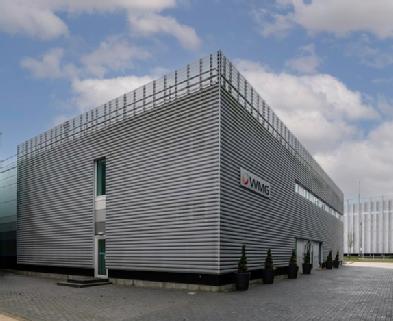 Researchers at WMG, University of Warwick’s, International Institute for Nanocomposites Manufacturing (IINM) have been working with the team at Versarien plc on a new comprehensive portfolio of graphene and related nanomaterial based thermoplastic polymer compounds and masterbatches.
Researchers at WMG, University of Warwick’s, International Institute for Nanocomposites Manufacturing (IINM) have been working with the team at Versarien plc on a new comprehensive portfolio of graphene and related nanomaterial based thermoplastic polymer compounds and masterbatches.
The new PolygreneTM compounds are expected to have potential commercial applications in areas as diverse as sports equipment, construction products, aerospace and automotive components.
Since 2018, Versarien subsidiary 2-DTech Ltd (2DT), Composites UK member, has funded PhD and postdoctoral researchers to understand the use of its Nanene™ graphene powders and other nanomaterials in thermoplastic systems. Dr David Reinoso-Arenas, the first 2DT funded PhD student, with support from the EPSRC Doctoral Training Programme, worked with Versarien’s Nanene™ materials in thermoplastic elastomer (TPE) systems and joined Versarien full-time last year as part of the team at Versarien’s subsidiary Cambridge Graphene Ltd.
Dr David Reinoso-Arenas, explained: “The new PolygreneTM thermoplastics portfolio is a culmination of my PhD research, some of which is due to be published in peer-reviewed journals. Since then we’ve been able to further develop and test these materials using different nanomaterial fillers and process conditions to fully optimise the resulting product performance. My PhD experience at the IINM and WMG was really enjoyable and enabled me to work closely with industry to ensure that the outputs of my research could be validated and have commercial viability.”
David’s PhD was performed under the supervision of Professor Tony McNally, whose team has an established capability in incorporating a wide range of nanomaterials into bulk polymer systems.
Professor Tony McNally, who leads the Nanocomposites Research Group at WMG, University of Warwick, said: “Working with Versarien over the last few years has given the IINM and WMG access to alternative graphene materials that have shown interesting phenomena when blended in these TPE systems. By tuning the nanofiller loading and optimising process conditions, David’s research showed that exceptional gains can be achieved in mechanical properties across the board (tensile strength, modulus, elongation at break, toughness and abrasion resistance) without compromising any properties. The addition of graphene also highlights improvements in polymer processing which may offer lower energy usage and, therefore, improving sustainability.”
Professor McNally continues to work with Versarien by providing a funded PhD position in 2D material based rubber systems, making use of the IINM’s new state of the art rubber processing and testing capabilities With support from the High Value Manufacturing Catapult (HVMC), WMG has established a world class facility for the study of elastomers.
Dr Stephen Hodge, Versarien’s CEO, added: “We look forward to continuing our collaboration with the IINM and WMG in rubber processing and understanding the interactions of our graphene and other 2D materials in these more complex systems, and hope to be able to demonstrate significant benefits that can impact upon real-world applications.”
Find out more and download technical datasheets here: https://versarienproducts.co.uk/thermoplastics
Find out more about WMG’s Nanocomposites research here:https://warwick.ac.uk/fac/sci/wmg/research/materials/nanocomposites/
Composites award wins for WMG research
Two WMG research projects, Project AMICABLE and Project TUCANA, were recognised at the Composites Industry Awards this week.
Project AMICABLE, a 12-month Innovate UK funded project, which set out to produce a lightweight, permanently antimicrobial grab pole for use in public transport, won the Innovation in Composite Materials award.
transport, won the Innovation in Composite Materials award.
Researchers from WMG’s Lightweight Materials and Manufacturing team worked with, product designers Transport Design International (TDI), anti-microbial additive developers BioCote and Promethean Particles and the Health and Safety Executive (HSE), and manufacturers Composites Braiding Ltd (CBL), to produce lightweight composite grab-poles with an embedded anti-microbial property.
The anti-microbial grab poles can be used in a wide range of public transport applications, such as bus, tram, rail and underground, helping to reduce transmission of infections.
A second project involving experts from WMG, called Project Tucana and led by Jaguar Land Rover, was recognised in the Innovation in Composite Design category.
The APC funded project is an enabler for future generations of Battery Electric Vehicles (BEV), demonstrated through the redesign of the rear structure of a Jaguar I-Pace, the acclaimed Jaguar Land Rover (JLR) BEV, bringing together a consortium of world-leading academic and industry partners. Researchers and engineers from WMG’s Automotive Composites Research Centre helped to develop the manufacturing technology to design stiffer and lighter vehicle structures using light weight carbon fibre materials.
Read more about the Composites Industry Awards here: Composites Industry Awards | Composites UK
Coventry’s Affordable Very Light Rail Track Unveiled
§ As part of Coventry Very Light Rail (VLR), Coventry City Council’s flagship transport project, a novel track form has been designed and manufactured by researchers from WMG, University of Warwick, together with their design partners Ingerop/Rendel.
§ The track sits just 30cm into the road surfacing, whereas traditional tram tracks typically involve digging a metre down and moving utilities such as water, gas and electricity.
§ As a result of its shallow depth and ability to be embedded in an existing highway the cost is significantly lower.
§ The urban VLR track may cost as little as £10m per km to install, compared to traditional trams which cost upwards of £25m per km, sometimes as much as £100m per km in city centre locations, making urban rail a possibility for smaller towns and cities in the future.
Coventry Very Light Rail (VLR) took a major step forward on 24 September as Coventry City Council and WMG, University of Warwick showcased a breakthrough new track design which aims to drive down the costs associated with the installation of urban light rail.
Bringing together stakeholders from Coventry and across the West Midlands, engineers from WMG, University of Warwick provided further details on the Coventry VLR track form, which has been designed in partnership with Ingerop and its UK subsidiary Rendel.
At the University of Warwick’s ‘The Slate’ conference centre researchers from WMG, University of Warwick spoke about the engineering challenges that had been overcome in the design of the track form.
Councillor Jim O’Boyle, cabinet member for jobs, regeneration and climate change at Coventry City Council, spoke about the potential for Coventry Very Light Rail to transform public transport in Coventry and in smaller and medium sized towns and cities, enabling the next generation of clean, green transport.
WMG, University of Warwick and Ingerop have successfully created, designed and built the novel track form, designed to sit just 30 cm inside the road surface, making it easy to install and remove, significantly reducing the impact on utilities and potentially saving millions of pounds lost to excavation and moving gas, electrical and telecommunication systems. The new track is expected to cost as little as £10m per km compared to current tram tracks, which can cost upwards of £25m per km, and up to £100m per km in city centre locations.
The track form has been developed in parallel to a zero-emission, battery-powered lightweight shuttle vehicle developed in partnership with TDI, which will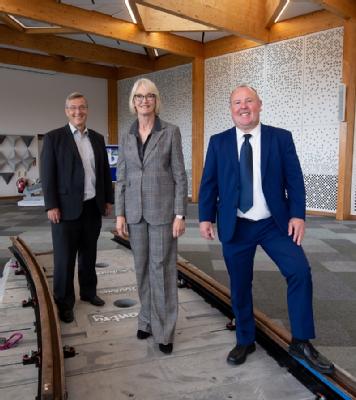 become autonomous, working like the London Underground system, where there is no timetable and passengers can hop on and off.
become autonomous, working like the London Underground system, where there is no timetable and passengers can hop on and off.
The vehicle is lightweight, and there will be no overhead power supply which is both costly and can have a negative impact to the city-scape.
Councillor Jim O’Boyle, cabinet member for jobs, regeneration and climate change, said:
”It’s incredible to see this one-of-a-kind, Coventry-led project move even closer to completion. Coventry Very Light Rail has the potential to provide Coventry, and towns and cities across the UK, with an affordable, high-quality transport mode using clean, green energy and it further cements our ambition to lead the green industrial revolution. Originated, designed and developed right here in Coventry it also has the potential to support new jobs in the future.
“This new track form, the first of its kind, is a critical part of the project and we would not be here today without the help of our incredible partners, some of the best engineering talent anywhere in the world, based right here in Coventry. I want to congratulate WMG and Ingerop on their success so far and I look forward to seeing the first tracks laid on our city’s streets.”
Dr Darren Hughes, Associate Professor at WMG, University of Warwick comments:
“The main driver of the Coventry VLR project was to make light rail as affordable and environmentally friendly as possible, and the track is the major part of this.
“Working with Ingerop we have successfully achieved this goal, making a unique track form using advanced materials and manufacturing processes which is not only affordable but also allows rapid installation, minimising disruption to local properties and businesses. The progress made is an excellent example of a city council, a university and an industry partner working together to solve a public transportation challenge.”
Margot James, Executive Chair at WMG, said:
“It is very exciting to see the latest development in the Coventry VLR project. The track technology is a world first, and reaching this milestone is a testament to the strength of the consortium and the hard work of all our partners. I am thrilled at the pivotal role WMG and the University of Warwick have played in this ground-breaking piece of work.”
Philippe-André Hanna, Director for Transportation at Ingerop added:
“We work all around the world on light rail schemes, in France, Spain, Africa and in the Americas and these have been very successful in bringing affordable public transport to urban areas. Light rail provides comfort, safety and frequent services, and has the potential to take people out of their cars, and reduce air pollution. We had been working over many years on how to optimise the depth of the trackform from the usual typical depth of 56cm one in order to reduce costs and to avoid having to divert any utilities.
“When we met WMG, University of Warwick and Coventry City Council, we were immediately struck by the potential to bring about a revolution in the light rail market and found the project extremely exciting. Together with WMG, and our UK subsidiary Rendel, a company active for more 175 years in the UK, we created a fully integrated team and found a true spirit of a collaboration within the whole group. This allowed us to create a great product, which is extremely innovative, and thanks to that we have succeeded to reach a new standard of a 30cm depth of trackform construction. Reducing the depth of excavation, and avoiding the diversion and impact on all utilities, we expect a much lower cost of construction than the usual light rail systems.
“We are looking forward to installing the first slabs in the road in Coventry and thereafter providing Coventry with a new innovative, cost effective, comfortable and regular public transportation system.”
Coventry VLR is being led by Coventry City Council and supported by a number of partners, including the Black Country Local Enterprise Partnership, Coventry and Warwickshire Local Enterprise Partnership, Dudley Metropolitan Borough Council and the European Regional Development Fund.
-ENDS-
27 SEPTEMBER 2021
NOTES TO EDITORS:
High-res images available here:
IMAGE 1 LANDSCAPE
CAPTION:
Pictured left to right: Margot James (Executive Chair, WMG), Stuart Croft (Vice Chancellor, University of Warwick and Councillor Jim O’Boyle (Cabinet Member for Jobs, Regeneration and Climate Change, Coventry City Council), stand on the new Coventry VLR track form.
IMAGE 2 PORTRAIT
CAPTION:
Pictured left to right: Stuart Croft (Vice Chancellor, University of Warwick) Margot James (Executive Chair, WMG), and Councillor Jim O’Boyle (Cabinet Member for Jobs, Regeneration and Climate Change, Coventry City Council), stand on the new Coventry VLR track form.
Credit: Coventry City Council
For further information on the track please contact:
Alice Scott
Media Relations Manager – Science
University of Warwick
Tel: +44 (0) 7920 531 221
E-mail: alice.j.scott@warwick.ac.uk
For further information on the Coventry VLR project please contact:
Liam Hughes
Assistant Communications Officer
(Very Light Rail and Our Future Moves)
Coventry City Council
Tel: +44 24 7538 1192
Email: liam.hughes@coventry.gov.uk
Pioneering industry collaboration accelerates hydrogen refuelling innovation for HGVs
WMG is working with Midlands-based SME Hy-Met Limited and Logan Energy to deliver the Hydrogen Prototype Equipment for Refuelling (HyPER) project.
Together, the consortium will develop a next-generation hydrogen flowmeter for refuelling Heavy Goods Vehicles (HGVs). These will be used for hydrogen refuelling systems, and will be lightweight, smaller, more cost effective and more accurate than existing instruments.
refuelling systems, and will be lightweight, smaller, more cost effective and more accurate than existing instruments.
This follows recent funding from the UK Government’s Department of Transport zero emission road freight trials through Innovate UK. The project value totals around £170,000.
The new meter will also be easier to manufacture and maintain than current options on the market.
The project aims to reduce the cost of hydrogen refuelling and enable the wider adoption of hydrogen by transport fleets and other users.
Nishal Ramadas, co-founder and CEO of Hy-Met, said: “Since launching Hy-Met in January, we’ve been motoring ahead with our plans to help with the transition to net zero. With our innovative measurement platform, Hy-Met is combining our deep hardware and software expertise to tackle some of the complex measurement challenges facing the hydrogen sector.
“When building the consortium, we knew we needed partners with detailed knowledge of the requirements for hydrogen refuelling and advanced manufacturing and prototyping capabilities.
“Our choice of project partners was clear and we are very happy Logan Energy and WMG have joined us in tackling this refuelling challenge.”
Bill Ireland, Chief Executive at Logan Energy, said: “Using hydrogen to power lorries is one of the key steps towards helping Scotland and the UK tackle the climate emergency.
“Making the switch from burning diesel to using hydrogen will cut the amount of carbon dioxide and other harmful gases being pumped into the atmosphere.
“There are a number of advancements we need to take before hydrogen becomes commonplace on our roads and one of the crucial elements is making it cheap and easy to refuel.
“For nearly three decades Logan Energy has been at the forefront of developing new and innovative hydrogen technologies both here in the UK and abroad. This collaborative partnership with Hy-Met and WMG is another step towards helping the UK grow its capabilities within the hydrogen industry and the drive to net-zero.”
Dmitry Isakov, Assistant Professor at WMG, said: “Securing this funding from the Department of Transport through Innovate UK will help us to accelerate our work. Working alongside Logan Energy and Hy-Met will allow us all to combine our knowledge and expertise to develop an industry-leading hydrogen flowmeter.”
Crash-resistant glazing installed on the new Coventry Very Light Rail Vehicle
· Crash-resistant glazing features on the new Coventry Very Light Rail vehicle, and could be used to improve passenger safety in other means of public transport
· The glazing is made of a highly resilient polymer and has been designed by engineers from WMG - University of Warwick, Far-UK and TDi Ltd.
· The glazing, which is highly resistant to failure, has advanced coating to increase product lifetime.
A new form of window glazing featuring a lightweight polymer with an advanced scratch-resistant coating has been installed on the Coventry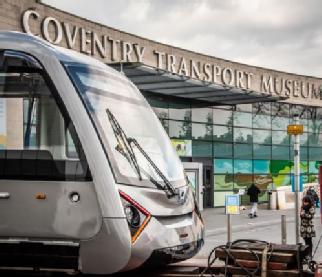 Very Light Rail vehicle, and could be used in other means of public transport. The new windows are highly resistant to breakage which provides passengers with a step-change in safety.
Very Light Rail vehicle, and could be used in other means of public transport. The new windows are highly resistant to breakage which provides passengers with a step-change in safety.
The glazing has been designed by a collaboration of WMG - University of Warwick, Far-UK (Lead) and TDi Ltd and was funded via the UK Innovation agency, Innovate UK (SBRI Rail Demonstrations: First of a Kind 2020).
The official report into the 2016 Sandilands (Croydon) tram crash made a number of recommendations for tram vehicle improvements. It called for development of windows and doors with improved strength. To address this need, researchers have been on a mission to make public transport safer in new innovative ways, one of which features crash-resistant glazing.
The new glazing is now revealed on the newly developed Coventry Very Light Rail vehicle, thanks to the Innovate UK funded project “Resilient glazing for safer passenger vehicle operation” (Resi-Glaze), which is an exciting collaboration between industry and academia.
The new glazing has been fully tested to ensure that it can survive exposure to severe projectile impact, all weather conditions, and has no negative impact on the environment compared to glass.
The technical team was then able to install it on the new Coventry Very Light Rail vehicle, meaning that the vehicle now holds two public transport firsts, as it has anti-microbial grab poles and crash-resistant glazing.
Dr Darren Hughes, from WMG at the University of Warwick comments:
“The new Coventry Light Rail vehicle has a number of major innovations including being lightweight, battery-powered and having reduced environmental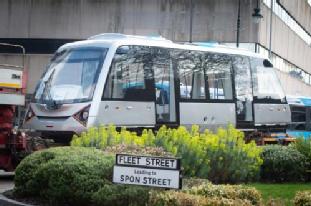 footprint. The vehicle has shown that major steps forward can be made using a UK-centric manufacturing approach. The Sandilands accident report identifies clearly the need for safer glazing in trams and we decided this would be the perfect opportunity to design and make the glazing and see it installed. Although we have demonstrated the technology in trams, we believe it points a path for safer future glazing solutions in the wider rail sector.”
footprint. The vehicle has shown that major steps forward can be made using a UK-centric manufacturing approach. The Sandilands accident report identifies clearly the need for safer glazing in trams and we decided this would be the perfect opportunity to design and make the glazing and see it installed. Although we have demonstrated the technology in trams, we believe it points a path for safer future glazing solutions in the wider rail sector.”
Dr Sophie Cozien-Cazuc from Far-UK Ltd adds:
“Far-UK has been thrilled to be given the opportunity to develop and manufacture resilient lightweight polymeric panels for the Coventry Very Light Rail vehicle. After the Croydon accident in November 2016, there was the need for more robust glazing options. This Resi-Glaze project allows innovations from other transport sectors to be brought to the rail industry. Polycarbonate glazing has moved on from the 1980s. Far is looking forward to providing this new glazing in the transport sector in general.”
Paul Salkeld from TDi Ltd adds:
“Transport Design International have been involved in many innovative projects over the years and this project has sound relevance as we look to promote safer and cleaner ways of providing public transport. We are looking forward to seeing this moving forward now in many applications.”
Councillor Jim O’Boyle cabinet member for jobs, regeneration and climate change said:
“I am delighted that this glazing innovation is being tested as part of our vehicle development. It will also have much wider application too, which is very exciting.
“We are right at the front of the green industrial revolution and our plans for Very Light Rail have already achieved a number of world first developments. The Coventry Very Light Rail project has the potential to revolutionise the way people travel, importantly at an affordable cost, and it will take another step forward later this year when both our new vehicle and our innovative track system is tested in real-world conditions.”
ENDS
14 JULY 2021
NOTES TO EDITORS
High-res images available at:
https://warwick.ac.uk/services/communications/medialibrary/images/march_2021/dsc_3057_002.jpeg
Caption: The glazing of the Coventry VLR as seen in situ
Credit: WMG, University of Warwick
https://warwick.ac.uk/services/communications/medialibrary/images/march_2021/230321vlr_citycentre_006.jpg
Caption: The glazing of the Coventry VLR as seen in situ
Credit: WMG, University of Warwick
https://warwick.ac.uk/services/communications/medialibrary/images/march_2021/230321vlr_citycentre_063.jpg
Caption: The glazing of the Coventry VLR as seen in situ
Credit: WMG, University of Warwick
For further information please contact:
Alice Scott
Media Relations Manager – Science
University of Warwick
Tel: +44 (0) 7920 531 221
E-mail: alice.j.scott@warwick.ac.uk
Additive layer manufacturing supply chains to be protected from cyber-attacks in light of COVID-19
· Additive manufacturing was upped during the COVID-19 pandemic to make ventilators, however when production was up so were the number of cyber-attacks
· In order to continue production without disruption new technologies are needed, which researchers from WMG, University of Warwick aim to deliver thanks to a grant from EPSRC
· Working with partners the new technologies developed will secure the supply chain in case of another global threat
The COVID-19 pandemic highlighted just how vulnerable UK manufacturing supply chains are, as there was an increase in the volume of cyber- enabled attacks on cyber-physical systems. There is therefore an urgent need to develop technologies and methods to support disruption-resilient manufacturing.
enabled attacks on cyber-physical systems. There is therefore an urgent need to develop technologies and methods to support disruption-resilient manufacturing.
This has been made possible, thanks to over £1 million of funding from the EPSRC, which will enable Dr Greg Gibbons, Prof Carsten Maple and Dr Greg Epiphaniou from WMG, and other colleagues from Henley Business School and Surrey Business School, to research into disruption-resilient-manufacturing.
Their project, entitled, ‘Responsive Additive Manufacturing to Overcome Natural and Attack-based disruption (RAMONA)’, will address the need and opportunity for the UK to become global leaders in responsive manufacturing, taking advantage of the opportunities presented by UK strengths in Additive Manufacturing.
The importance and limitations of responsive manufacturing systems – those that are able to respond to minimise the impact of a disruption – in the UK have been brought to the fore by COVID-19. Traditional supply chain weaknesses have been exposed, creating a ‘watershed’ moment for additive manufacturing, which could be used to complement existing manufacturing supply chains and embed resilience within them.
This was evidenced by the Ventilator Challenge UK, where additive manufacturing was a key technology in supporting the production of thousands of ventilators for the NHS within 12 weeks.
Additive Manufacturing has particular strengths in supporting distributed manufacturing, on-demand production, and rapid development and approval of component design. However, this type of responsive manufacturing capability is uncommon and requires further development before it can be embedded as an industry wide capability.
This will be achieved by addressing the following challenges:
- How to develop effective techniques to detect disruption
- How to effectively and accurately analyse the disruption; and
- How to respond to disruption through reconfigured manufacture.
 Dr Greg Gibbons, Reader in Additive Manufacturing in WMG at Warwick, comments:
Dr Greg Gibbons, Reader in Additive Manufacturing in WMG at Warwick, comments:
“This award is an exciting opportunity to engage in this timely and highly impactful research. It will enable us to develop the technologies required by UK manufacturing to ensure robust and reliable supply chains that can respond rapidly and optimally to disruptive threats, making a real difference to the security of supply when faced with global threats such as we have seen during the COVID Pandemic.
“It is fantastic to be able to collaborate with scholars, as well as leading organisations across a range of industries including automotive, defence, security and healthcare in developing solutions to the key challenges facing manufacturing today.”
Dr Gibbons will be working alongside colleagues from WMG, Henley Business School, University of Reading, and Surrey Business School at the University of Surrey. They will also be working with multiple project partners from industry, including Royal Berkshire NHS Foundation Trust and Thales Ltd.
The research will begin later in the year (September 2021) and is due to finish in early 2024. It received a total grant of £1,024,124. Find out more details of the grant.
ENDS
7 JULY 2021
NOTES TO EDITORS
High-res images available at:
https://warwick.ac.uk/services/communications/medialibrary/images/march2014/dr_greg_gibbons.jpg
Caption: Dr Greg Gibbons, from WMG, University of Warwick
Credit: WMG, University of Warwick
For further information please contact:
Alice Scott
Media Relations Manager – Science
University of Warwick
Tel: +44 (0) 7920 531 221
E-mail: alice.j.scott@warwick.ac.uk
WMG research is acknowledged at important industrial awards
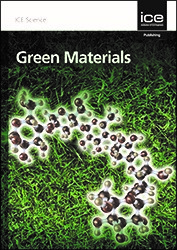 WMG Professor Ton Peijs’s paper entitled: “Turning low-cost recycled paper into high-value binder-free all-cellulose panel products” has been awarded the prestigious Green Materials Journal Prize by IEC Publishing, part of the Institute of Civil Engineers.
WMG Professor Ton Peijs’s paper entitled: “Turning low-cost recycled paper into high-value binder-free all-cellulose panel products” has been awarded the prestigious Green Materials Journal Prize by IEC Publishing, part of the Institute of Civil Engineers.
The IEC Awards recognise research of exceptional quality and benefit to the civil engineering, construction and materials science community.
Professor Peijs will be officially presented with the award at a ceremony in London in October.
Ton Peijs is a Professor of Polymer Engineering and Director of the National Polymer Processing Centre at WMG. His research focuses mainly on materials and processing innovations in polymers and composites. Ton has made notable contributions to areas such as hybrids, multifunctional materials, damage tolerance and durability, natural fibres and bio-based materials, polymer fibres and nanocomposites. He has also pioneered the development of sustainable composites, including the development of fully recyclable all-polymer composites.
Read Professor Peijs’s paper in full here: Turning low-cost recycled paper into high-value binder-free all-cellulose panel products | Green Materials (icevirtuallibrary.com)
Read more about WMG’s plastics research here: Plastics (warwick.ac.uk)
